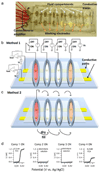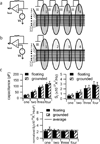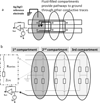Two approaches for addressing electrochemical electrode arrays with reduced external connections
- PMID: 27293487
- PMCID: PMC4898061
- DOI: 10.1039/C5AY00229J
Two approaches for addressing electrochemical electrode arrays with reduced external connections
Abstract
Although patterning hundreds or thousands of electrochemical electrodes on lab-on-a-chip devices is straightforward and cost-effective using photolithography, easily making connections between hundreds of electrodes and external amplifiers remains a bottleneck. Here we describe two electrode addressing approaches using multiple fluid compartments that can potentially reduce the number of external connections by ~100-fold. The first approach enables all compartments on the device to be filled with solution at the same time, and then each fluid compartment is sequentially electrically activated to make the measurements. The second approach achieves lower measurement noise by sequentially filling recording chambers with solution. We propose an equivalent circuit to explain measurement noise in these recording configurations and demonstrate application of the approaches to measure quantal exocytosis from individual cells. A principle advantage of using these approaches is that they reduce the fraction of the microchip area that needs to be dedicated to making external connections and therefore reduces the cost per working electrode.
Figures






Similar articles
-
Electrochemical measurement of quantal exocytosis using microchips.Pflugers Arch. 2018 Jan;470(1):97-112. doi: 10.1007/s00424-017-2063-2. Epub 2017 Sep 2. Pflugers Arch. 2018. PMID: 28866728 Free PMC article. Review.
-
Quantification of noise sources for amperometric measurement of quantal exocytosis using microelectrodes.Analyst. 2012 Jun 7;137(11):2674-81. doi: 10.1039/c2an35157a. Epub 2012 Apr 27. Analyst. 2012. PMID: 22540116 Free PMC article.
-
Nanoscale Electrochemical Sensor Arrays: Redox Cycling Amplification in Dual-Electrode Systems.Acc Chem Res. 2016 Sep 20;49(9):2031-40. doi: 10.1021/acs.accounts.6b00333. Epub 2016 Sep 7. Acc Chem Res. 2016. PMID: 27602780
-
On-Chip Cyclic Voltammetry Measurements Using a Compact 1024-Electrode CMOS IC.Anal Chem. 2021 Jun 8;93(22):8027-8034. doi: 10.1021/acs.analchem.1c01132. Epub 2021 May 26. Anal Chem. 2021. PMID: 34038637 Free PMC article.
-
Microfabricated reference electrodes and their biosensing applications.Sensors (Basel). 2010;10(3):1679-715. doi: 10.3390/s100301679. Epub 2010 Mar 2. Sensors (Basel). 2010. PMID: 22294894 Free PMC article. Review.
Cited by
-
Electrochemical measurement of quantal exocytosis using microchips.Pflugers Arch. 2018 Jan;470(1):97-112. doi: 10.1007/s00424-017-2063-2. Epub 2017 Sep 2. Pflugers Arch. 2018. PMID: 28866728 Free PMC article. Review.
-
A sandwich-type bacteriophage-based amperometric biosensor for the detection of Shiga toxin-producing Escherichia coli serogroups in complex matrices.RSC Adv. 2020 Sep 30;10(59):35765-35775. doi: 10.1039/d0ra06223e. eCollection 2020 Sep 28. RSC Adv. 2020. PMID: 35517084 Free PMC article.
-
Surface-modified CMOS IC electrochemical sensor array targeting single chromaffin cells for highly parallel amperometry measurements.Pflugers Arch. 2018 Jan;470(1):113-123. doi: 10.1007/s00424-017-2067-y. Epub 2017 Sep 9. Pflugers Arch. 2018. PMID: 28889250 Free PMC article. Review.
References
-
- Pei J, Tercier-Waeber ML, Buffle J, Flaccabrino GC, Koudelka-Hep M. Analytical Chemistry. 2001;73:2273–2281. - PubMed
-
- Wilson MS, Nie W. Analytical Chemistry. 2006;78:6476–6483. - PubMed
-
- Dias AF, Dernick G, Valero V, Yong MG, James CD, Craighead HG, Lindau M. Nanotechnology. 2002;13:285–289.
-
- Chen P, Xu B, Tokranova N, Feng X, Castracane J, Gillis KD. Analytical Chemistry. 2003;75:518–524. - PubMed
Grants and funding
LinkOut - more resources
Full Text Sources
Miscellaneous

